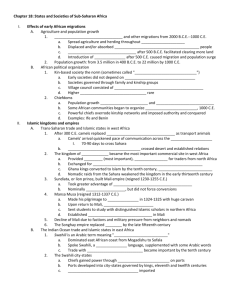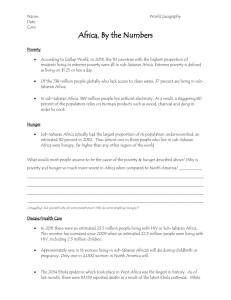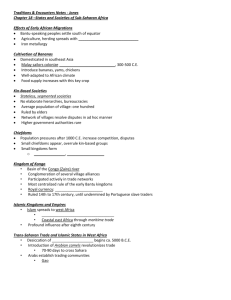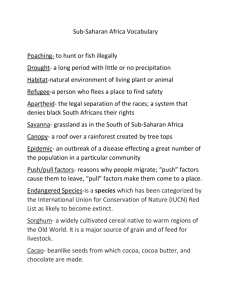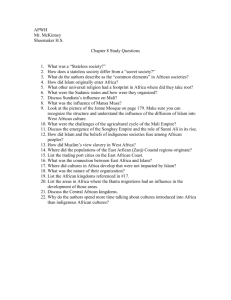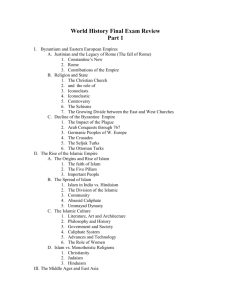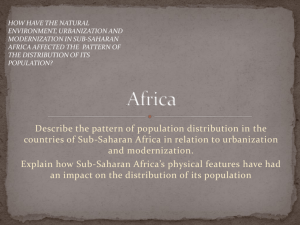Islamic Influence - People Search Directory
advertisement
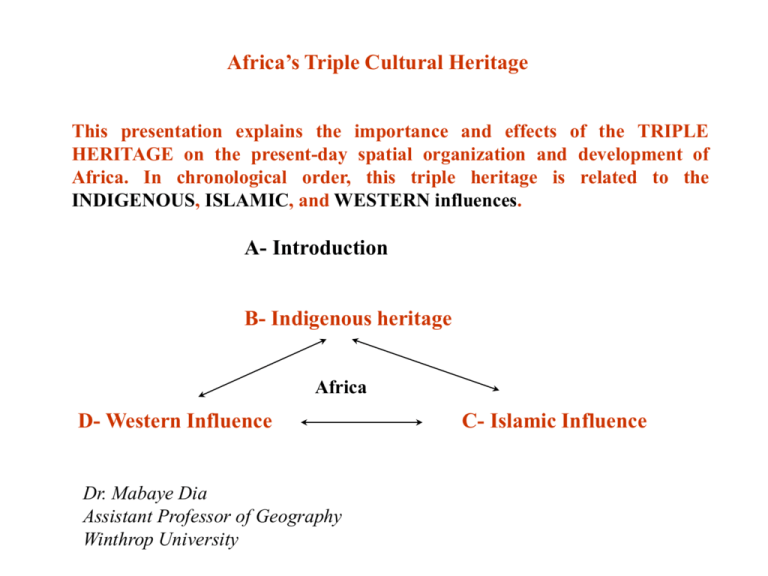
Africa’s Triple Cultural Heritage This presentation explains the importance and effects of the TRIPLE HERITAGE on the present-day spatial organization and development of Africa. In chronological order, this triple heritage is related to the INDIGENOUS, ISLAMIC, and WESTERN influences. A- Introduction B- Indigenous heritage Africa D- Western Influence Dr. Mabaye Dia Assistant Professor of Geography Winthrop University C- Islamic Influence (Major landforms in Africa, Osei, 2003) B- Indigenous heritage The history of the indigenous heritage is categorized into five major periods: B-1- Africa as the cradle of man B-2- The era of ancient civilizations B-5- The era of modern kingdoms B-3- The Iron and Late medieval period B-4- The Bantu migratory B-1 Africa as the cradle of man Zinjanthropos (1.8 million years old ) was discovered in the Olduvai Gorge in Tanzania (Mary Leakey, 1959) Lucy was discovery in the site of Hadar in Ethiopia (Donald Johanson and Tom Gray, 1974) Zinjanthropos (1.8 million years) Lucy: 3.2 Million Years These discoveries are strong indications that the African Rift Valley system was the first home of man. The first people of Africa lived in small bands of hunter-gatherers. About 12,000 years ago, hunter-gathers began to sett1e permanently along the Nile River to domesticate plants and animals and exchange goods. Thus, by 3,500 B.C. they developed structured political arrangements based on kinship and co-residency. Controversy exists as to whether ancient Egypt was white or black. Earlier historians allude to the fact that ancient Egypt was a white civilization, but the Afrocentric school, based on the work of Cheikh Anta Diop (1974), argues that it was black. Graham (1994) suggests that Egypt consisted of many colors; The important issue is that Ancient Egypt (3000 to 1070 BC) was an African civilization. B-2 The Era of Ancient Civilization (Ancient and Early Medieval Civilizations of Sub-Saharan Africa, Aryeetey-Attoh, 2003) These ancient societies have not been researched as extensively as Egypt, they were civilizations in their own right. All these civilizations were characterized by permanent settlement, domestication of plants (cereals and roots) and animals, and well-established political structures. Other distinguishing features were their use of iron in making tools and the long-distance trade networks they established. Kush was known for its impressive architecture (ruins of Meroe still exist today), irrigation systems, scripts, and for its large iron industry. B-3 Late Medieval Civilizations (Medieval Era: 475-1450 AD) (Late Medieval and Modern Kingdoms of Sub-Saharan Africa, Aryeetey-Attoh, 2003) B-4 Bantu Migrations in Sub-Saharan Africa •Based on linguistic associations, cultural trait similarities, and archeological artifacts have determined that beginning in about 5000 B.C. a series of migrations from the Benue River begun to fan out eastward and southwestward. •It is speculated that these migrations were caused by (Rowntree and Al., 2000) The need for more land for settlement and agricultural purposes as the original land culd no longer support the fast growing population. Ethinic wars forced some groups to leave for other places to the down south The search for game especially the elephant for ivory trading purposes B-5) The Era of Modern Kingdom (After 1450 A.D.) Toward the end of the medieval period, especially after 1600, a number of modern kingdoms emerged, particularly in the forest belt and in areas where the Bantu migrations had spread. In West Africa: the Cayor, Baol, Futa Toro, Fouta Djallon, Jolof, Kaarta, Segu, Macina, Ashanti, Gonja, Benin, Borgu, Nupe, Dahomey, and Oyo In central and East Africa: the Kuba, Lunda, Lozi, Kazembe, Malawi, Burundi, Rwanda, Buganda, Bunyaro, Nkore, Shona, and Angola. In Southern Africa: the Zulu, Ndebele, Sotho, and Swazi. Modern kingdoms emerged on the demise of the earlier medieval civilizations and were precipitated by trade in gold and slaves with north Africa, as well as the need to form political associations to protect both their trade routes and themselves. C- Islamic Influence Islam is not an African religion; it was introduced from the major source region, Arabia. Islam, however, is part of the Africa's heritage and its social, cultural, and religious fabric. Islam has existed in Sub-Saharan Africa since at least A.D. 700-1300. Today, the religion has a major influence on the cultural, economic, and political systems of regions, especially in the Sahel and Savanna belts of West Africa and along the coast of East Africa (Diffusion of Islam in Africa, Rowntree and Al., 2000) The Three specific paths of diffusion in Sub-Saharan Africa The first was by contact between Arabian traders and the people along the coast of East Africa and its surrounding islands (Zanzibar, Pemba, and the Comoros). This first wave of Islamic influence began around 700 A.D. These contacts and the subsequent spread of Islam were confined to the coast; The second wave of Islamic diffusion began around A.D. 900 and continued until the nineteenth century, For the most part, of the diffusion process was enhanced by trade via Trans-Saharan routes and Jihads, Holy Wars. The third way in which Islam diffused to Sub-Saharan Africa was by trade between Egypt and Arabia and within the horn of Africa (the easternmost African extension of land between the Indian Ocean and the Gulf of Aden): Islamization and Arabisation. Islam introduced a new religion and an Arabic language, helped in the formation of states, influenced the development of Swahili as a trade language, established the basis for an Arabic educational system, and influenced food choice and dress patterns. The relationship between Islam and indigenous cultures was more of a conversation than a domination: "Wolofisation" of the religion in Senegal (Amadou Bamba); “Pularization”of Islam in Fulani community of the Futa Toro Kingdon (Umar Futiyu). Reaction against Christianity as the colonial religion led to Islamic conversions: The use of the African drum in religious practices, the acknowledge of polygamy, Islam has been less critical of female circumcision. D-The Western Influence European contact of any consequence with Africa started in the middle of the fifteenth century (c. 1450). Of the three influences on Africa, the European influence was the shortest, and yet, the strongest and most pervasive in the region. The Western influence on Africa can be divided into four main periods (economic changing need of Europe: D-1The period of initial contact (1450-1500s) D-4 The colonial period (1880s-1960s) D-2 The period of enslavement (1500s-1840s) D-3 The age of land exploration (1840-1880s) D-1The Period of initial contact with Africa ( c. 1450s) •The first meaningful contact between Europeans and Africans was, to a large extent, incidental rather than planned. Europe was searching for a sea route to India because Arabic people, who controlled the land route, posed a threat to their trade in silk, porcelain, and spices. •Portugal was the first country to sponsor expeditions to Sub-Saharan Africa, followed by the Dutch, Danes, British, French, Germans, Italians, and Spaniards. •The first contacts were in West Africa and limited only to the coast, partly because established kingdoms prevented Europeans from penetrating the interior to disrupt their trade. •Coastal trade included the exchange of gold, ivory , cola nuts, and palm products from Africa for alcohol, guns, and sugar from Europe. D-2 The Enslavement of Sub-Saharan Africans to the Americas (1500s and 1840s) Trade between Europe and Sub-Saharan Africa continued until Europe 'discovered' the Americas in 1492. The potential of the Americas to provide commodities such as tobacco, sugar cane, and cotton changed the nature of the relationship between Sub-Saharan Africa and Europe. The native Indian population had either been decimated by European diseases or could not be held as captive labor to work on plantations. Therefore, Europe turned to Africans as a source of workers for their plantations (Rowntree and Al., 2000) (Rowntree and Al., 2000) The abolition resulted from humanitarian efforts in the United States and Europe. The activities of the "Back to Africa Movement" and the "Maroon" communities, were instrumental in this effort. Western-educated and freed slaves such as Olaudah Equiano of Nigeria and Ottabah Cugoano of Ghana also played a major role in the abolition process. D-3 The age of land exploration (1840s-1870s) In spite of the fact that Europe's interests in Sub-Saharan Africa had waned after the era of slavery, The INDUSTRIAL REVOLUTION provided an impetus for Europe to maintain its presence in the region. Between 1840 and 1890, land explorers such as Henry Stanley (an American employed by King Leopold of Belgium), David Livingstone (along the Zambezi), and Mungo Park (along the Niger River). In Southern Africa, the British and Dutch (Boers or Afrikaners) had begun to colonize territory during this period. This was largely due to the appeal of the Mediterranean climate and the abundance of mineral resources in the region: Anglo-Boers War (1899-1909) D-4 The colonial period (1880s-1960s) The reports of explorers about the resource potential of Sub-Saharan Africa led to intense competition for territory amongst European powers and set the stage for the “scramble” for territory European nations met in Berlin (Berlin Conference, 1884) to determine the ground rules for the partitioning of Sub-Saharan Africa into British, French, Portuguese, German, Belgian, Italian, and Spanish territories (Rowntree and Al., 2000) Apartheid: An official policy of racial segregation (white, coloured (mixed race), Indian (South Asian), African (black)) that shaped political, legal and social relations in South Africa for nearly 50 years. The colonial period in SubSaharan Africa lasted for only about 75 years for most countries, but it had the most pervasive impact. European Colonization in 1913. (Rowntree and Al., 2000) D-4-1 The Economic Impacts of Colonialism Te prime objective behind Europe's colonization of other regions was to extract agricultural and mineral resources to feed the burgeoning industries at home (Europe). Europe had to link Africa to the world economy in a peripheral and subordinate manner to reap the benefits of its policy The dual economy consisted of a modern cash crop (cocoa, coffee, tea, rubber, timber, cotton) and mineral (gold, bauxite, copper) export sector that coexisted with a traditional, food crop (millet, maize, yam, plantain) sector geared largely for local consumption. D-4-2 The Political and Socio-cultural Impacts of Colonialism Colonialism has resulted in three major political and Socio-cultural dilemmas for present-day countries: The arbitrary way in which the region was partitioned at the Berlin conference of 1884. Basically, geometric lines were drawn on a map to form colonies without any regard to the distribution of ethnic groups To Ensure law and orde, Each colonial power relied on its own administrative: (British, indirect ruel); (French: assimilation); (Belgians were paternalistic and governed their territories) Political independence was accompanied by the adoption of Western models of government, which were characterized by the nation-state concept: separation of the executive, legislative, judiciary, and military D-4-3 Independence from the West Colonialism was largely detrimental to the social and economic well-being of Africans. After World War I (1914-1918), with Italy's invasion of Ethiopia in 1936, a nationalistic attitude emerged in Sub-Saharan Africa with an emphasis on independence and self-determination. After World War II First, the independence of India (then known as the Jewel of the British Empire) in 1947 stirred much optimism in African colonies. Second, Pressure Groups who had witnessed the inhumanity of colonialism, while fighting side by side with their African counterparts in World War II, began to urge leaders in European capitals to end colonization. Third, African Students such as K. Nkrumah (Ghana), C.A. Diop (Senegal), and L.S. Senghor (Senegal) returned home to organize political platforms. In Kenya, the Kikuyu-led Mau Mau movement (J. Kenyatta) resisted the colonial and missionary annihilation of local culture. Fourth, civil rights movements in the United States linked their cause to the independence struggles in Sub-Saharan Africa, giving them more recognition in the United States (the new world power after World War II). Fifth, Europe was decimated during World War II and had to turn to America for help in reconstructing its economy and infrastructure. This made the cost of administering colonies even more burdensome The cumulative effect of these factors resulted in Ghana being the first colony to attain its independence in 1957. By 1965, almost all African countries had obtained their independence. Conclusion: 1. The history of Africa is the result of the combined effects of three main influences: Indigenous, Islamic and Western (especially colonialism). 2. Because several ancient, medieval, and modern civilizations existed in various parts of Africa, subtle differences exist in the effects of the indigenous heritage from region to region. Yet, there are some underlying commonalities that link the cultures of Africa. 3. The Islamic influence is localized mostly in the northern savanna, Sahel, and desert regions of West Africa and the coastal regions of East Africa. 4 The effect of the trans-Atlantic Stave Trade was devastating, especially in the middle belt of West Africa 5 All colonial powers were bound by the single purpose of extracting resources from their colonies, thus relegating African colonies to a state of economic and cultural dependency.
